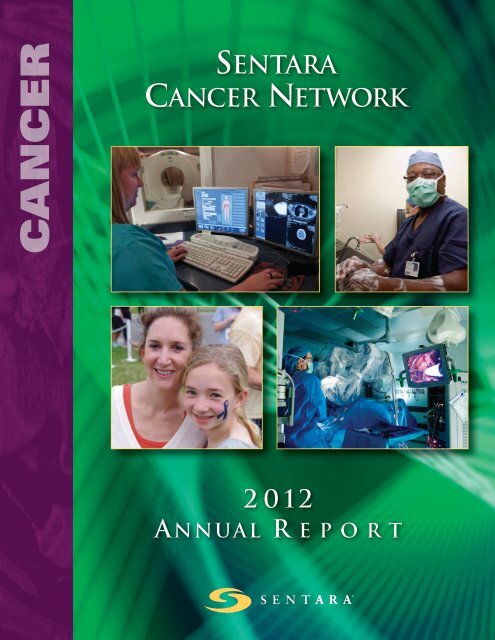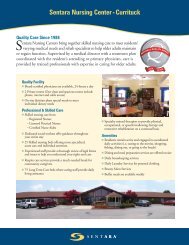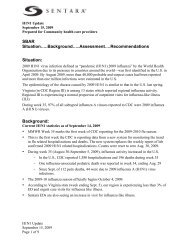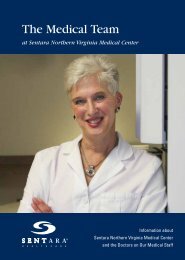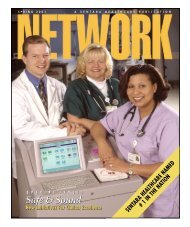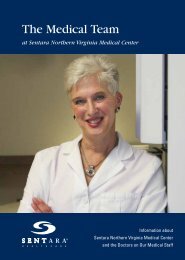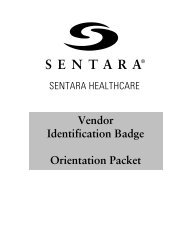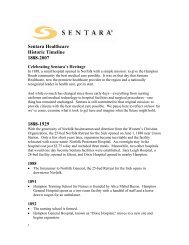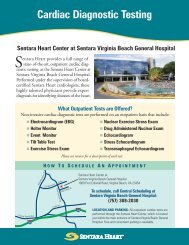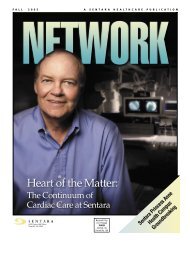2012 Annual Report - Sentara.com
2012 Annual Report - Sentara.com
2012 Annual Report - Sentara.com
Create successful ePaper yourself
Turn your PDF publications into a flip-book with our unique Google optimized e-Paper software.
CANCER<br />
<strong>Sentara</strong><br />
Cancer Network<br />
2 0 1 2<br />
<strong>Annual</strong> R e p o r t
<strong>Sentara</strong> Cancer Network - By the Numbers<br />
More than<br />
6,000<br />
cancer patients<br />
treated each year<br />
More than<br />
66,000<br />
patients documented<br />
in Cancer Registry<br />
since 1995<br />
9,961<br />
Cases Presented in<br />
Cancer Conferences<br />
(2007-2011)<br />
13<br />
facilities providing care<br />
to cancer patients<br />
Contents<br />
3 <strong>Sentara</strong> Cancer Network<br />
7 Colorectal Cancer<br />
10 Breast Cancer<br />
14 Thoracic Cancer<br />
16 Pancreatic Cancer<br />
18 Prostate Cancer<br />
20 Head and Neck Cancer<br />
22 Hematology/Oncology<br />
24 2011 Primary Site Data<br />
26 Network Cancer Conferences<br />
Note: The data shared in this report is the most<br />
currently available from the National Cancer Database<br />
and the <strong>Sentara</strong> Cancer Network registries.<br />
More than<br />
70<br />
More than<br />
17,921<br />
clinical trials<br />
available for patients<br />
<strong>com</strong>munity members reached<br />
through outreach programs in 2011
A positive patient experience is critical.<br />
We believe our patients deserve the very best<br />
every time they walk through our doors.<br />
Figure 1.<br />
2011 <strong>Sentara</strong> Cancer Network Top 15 Analytic Cancer Sites<br />
Breast cancer is the leading primary site, accounting for 25% (1,235 cases) of the total analytic cancer caseload (4,995 cases).<br />
Breast cancer is followed by lung cancer, prostate cancer, colon cancer, and melanoma as the top five sites for 2011. Other<br />
sites account for 16% of the total caseload and include all primary sites not in the top 14 for the <strong>Sentara</strong> Cancer Network.<br />
All Other Sites: 824 16%<br />
Breast: 1,235 25%<br />
Stomach: 64 1%<br />
Brain 88 2%<br />
Rectum: 96 2%<br />
Uterus: 110 2%<br />
Non-Hodgkin Lymphoma: 169 3%<br />
Pancreas: 142 3%<br />
Thyroid: 175 4%<br />
Kidney/Renal Pelvis: 184 4%<br />
Bladder: 199 4%<br />
Melanoma – Skin: 239 5%<br />
Colon: 329 7%<br />
Lung<br />
673 13%<br />
Prostate: 468 9%<br />
www.sentara.<strong>com</strong>/cancer 3
Collaboration. <strong>Sentara</strong> Cancer Network physicians and healthcare<br />
professionals work together using their skills, knowledge and experience<br />
to help deliver the best quality out<strong>com</strong>e and personalized care<br />
for cancer patients in the <strong>com</strong>munity.<br />
The <strong>Sentara</strong> Cancer Network:<br />
n Partners with Eastern Virginia Medical School and<br />
Virginia Oncology Associates, allowing patients to tap<br />
into a <strong>com</strong>prehensive network of multi-disciplinary<br />
cancer care, from diagnosis to recovery.<br />
n Offers quality care with a collaborative approach and<br />
access to extensive clinical research.<br />
n Includes a vast network of physician experts, an<br />
invaluable resource to the Hampton Roads <strong>com</strong>munity.<br />
n Treats more than 6,000 cancer patients each year.<br />
No matter where you enter the <strong>Sentara</strong> Cancer Network,<br />
you have the support and <strong>com</strong>bined expertise of cancer specialists<br />
working together to provide a dedicated approach to care.<br />
A proven track record of quality, advanced care –<br />
One of the largest in the nation, the <strong>Sentara</strong> Cancer<br />
Network is the only accredited cancer network in<br />
Virginia, a distinction from the American College<br />
of Surgeons Commission on Cancer, which means<br />
we are held to the highest standards in delivering<br />
cancer care to our <strong>com</strong>munity. The <strong>Sentara</strong> Cancer<br />
Network was re-accredited in <strong>2012</strong> with all eight of<br />
the possible <strong>com</strong>mendations.<br />
4 <strong>Sentara</strong> Cancer Network <strong>2012</strong> <strong>Annual</strong> <strong>Report</strong>
Cancer patients can rest assured that the most Innovative, sophisticated Technology<br />
is being deployed to diagnose and treat cancer. The <strong>Sentara</strong> Cancer Network is helping more<br />
patients in our <strong>com</strong>munity survive cancer every day.<br />
The <strong>Sentara</strong> Cancer Network is at the forefront of cancer advances,<br />
providing services <strong>com</strong>parable to the nation’s most highly<br />
regarded hospitals and medical centers.<br />
n National Accreditions from the American College of Surgeons’<br />
Commission on Cancer, the National Accreditation Program<br />
for Breast Centers, and the American College of Radiology.<br />
n Fellowship Trained Physicians<br />
n Comprehensive Team Approach to Cancer Diagnosis<br />
and Treatment<br />
n Access to Clinical Trials and Genetic Counseling Services<br />
n Advanced technology that is <strong>com</strong>parable to the nation’s<br />
most highly regarded hospitals and medical centers, including<br />
CyberKnife®, daVinci®, IntraBeam® and other surgical and<br />
radiation oncology therapies.<br />
Figure 2.<br />
<strong>Sentara</strong> Cancer Network Cancer Conference Program -<br />
Number of Cases Presented 2007 – 2011<br />
During these conferences, physicians meet to share expert knowledge and create<br />
individualized care plans to ensure the best possible patient out<strong>com</strong>es.<br />
3,000<br />
2,500<br />
2,000<br />
1,970<br />
2,188<br />
2,399<br />
2,290<br />
1,500<br />
1,000<br />
1,144<br />
500<br />
0<br />
2007<br />
2008<br />
2009<br />
2010<br />
2011<br />
www.sentara.<strong>com</strong>/cancer 5
At <strong>Sentara</strong>, our Commitment is to provide innovative services to promote the improvement<br />
of personal health throughout Hampton Roads. With multiple convenient locations<br />
throughout the region, a myriad physician experts and innovative technology,<br />
the <strong>Sentara</strong> Cancer Network provides the resources the <strong>com</strong>munity needs for prevention,<br />
diagnosis and treatment of cancer.<br />
<strong>Sentara</strong> Network Cancer Steering Committee Members<br />
Physicians<br />
Thomas Alberico, MD – Medical Oncology,<br />
Cancer Committee Chair<br />
James Schneider, MD – Surgical Oncology,<br />
Cancer Liaison Physician<br />
Victor Archie, MD – Radiation Oncology<br />
Bruce Booth, MD – Medical Oncology<br />
Joseph Dalton, MD – General Surgery<br />
Krista Dobbie, MD – Palliative Care<br />
Eric Feliberti, MD – Surgical Oncology<br />
Mark Fleming, MD – Medical Oncology<br />
Richard Hoefer, DO – Surgical Oncology<br />
Lester Johnson, MD – Radiology<br />
John Patterson, MD – Hospice and<br />
Palliative Medicine<br />
Marc Silverberg, MD – Pathology<br />
Scott Williams, MD – Radiation Oncology<br />
Jason Wilson, MD – Surgical Oncology<br />
Non-Physicians<br />
Cynthia Allen – Vice President,<br />
Ongology Services<br />
Deb Anderson – Strategy<br />
Joani Brough – Administration, SPAH<br />
Connie Bush – Community Outreach<br />
Janet Creef – Oncology Social Work<br />
Kimberly Dorsch – Clinical Research<br />
Nicky Dozier – Clinical Research, VOA<br />
Cindy Estes – Oncology Nursing<br />
Pennie Faircloth – American Cancer<br />
Society<br />
Cynthia Freeman – Cancer Registry<br />
Michael Gentry – Corporate Vice President<br />
James Hoy – Pastoral Care<br />
Vonia Ickes – Clinical Nutrition<br />
Joanne Inman – Administration, SVBGH<br />
Brad Kirby – Administration, <strong>Sentara</strong><br />
Cancer Network<br />
Tifany Lewis – VOA Genetics<br />
Kathleen Marcia – Cancer Registry<br />
Maureen McGrath – Administration, VOA<br />
Linda McKee – Administration, SCH/SWRMC<br />
Sylvia Richendollar – Administration, SNGH<br />
June Robertson – Administration, SVBGH<br />
Meredith Strand – Administration, SNGH<br />
Jennifer Taylor – Oncology Nursing<br />
Rose West – Marketing<br />
Lynne Whitlock – Administration, SOH<br />
Eric Young – Administration, SLH<br />
<strong>Sentara</strong> Healthcare is an acknowledged leader in patient safety and<br />
quality innovation. Founded in 1888 as the Retreat for the Sick in Norfolk, Virginia, <strong>Sentara</strong><br />
has ranked for more than a decade among the nation’s top integrated healthcare systems by Modern Healthcare magazine<br />
and was the #1 most integrated health care system for two years consecutively in 2010 and 2011. <strong>Sentara</strong>, a not-for-profit<br />
health system, operates more than 100 sites of care serving residents across Virginia and northeastern North Carolina.<br />
The system is <strong>com</strong>prised of 10 acute care hospitals, including 7 in Hampton Roads, 1 in Northern Virginia, and 2 in<br />
the Blue Ridge region, advanced imaging centers, nursing and assistedliving<br />
centers, outpatient campuses, a home health and hospice agency, a<br />
3,680-provider medical staff, and three medical groups with 618 providers.<br />
<strong>Sentara</strong> also offers medical transport ambulances and Nightingale, the first<br />
air ambulance serving Hampton Roads. Optima Health, an award winning<br />
<strong>Sentara</strong> owned health plan, serves 440,000 members in Virginia.<br />
6 <strong>Sentara</strong> Cancer Network <strong>2012</strong> <strong>Annual</strong> <strong>Report</strong>
Colorectal Cancer Program<br />
Team of Dedicated Specialists<br />
As part of the <strong>Sentara</strong> Cancer Network, the Colorectal<br />
Cancer Program offers a <strong>com</strong>prehensive network<br />
of dedicated specialists who meet regularly to<br />
collaborate and make re<strong>com</strong>mendations on patient<br />
treatment.<br />
At each hospital, patient cases are discussed at a<br />
very high, multi-disciplinary level with many different<br />
opinions put into the equation. All the slides and<br />
x-rays are reviewed, along with details of the patient’s<br />
history, and a consensus is determined followed by<br />
the development of a specific care plan.<br />
Collaboration for Quality Improvement<br />
The number one ac<strong>com</strong>plishment of the colorectal<br />
program this year is the reflective pathology testing<br />
(Immunohistochemical stains for mismatch repair<br />
proteins) of all colorectal specimens to identify<br />
those patients that need genetic testing for Lynch<br />
Syndrome. This testing was implemented in all<br />
Hampton Roads hospitals in July. This change will<br />
increase the ability to identify patients with high risk<br />
factors that need additional testing to determine the<br />
best long term treatment planning for them and their<br />
immediate family members.<br />
The Colorectal Cancer Program also launched<br />
a project to reduce surgical site infections related<br />
to cancer and non-cancer colorectal surgery. By<br />
improving the <strong>com</strong>munication process between<br />
the circulator and the surgeon, the accurate<br />
identification of wound class can be correctly<br />
benchmarked for national statistics.<br />
Figure 3.<br />
Observed Survival for Colorectal Cases -<br />
Figure 4.<br />
Observed Survival for Colorectal Cases -<br />
<strong>Sentara</strong> Cancer Network 2003 - 2005<br />
National Cancer Data Base for 2003 - 2005<br />
The graphs below are a <strong>com</strong>parison between the 5-year survival for colon cancer in the National Cancer Data Base 2003-2005 and the 5-year<br />
survival for the <strong>Sentara</strong> Cancer Network 2003-2005. Stage I, II, and IV are lower in <strong>Sentara</strong> than at the NCDB. Stage 0 and III are slightly higher<br />
than the National Cancer Data Base.<br />
Cumulative Survival Rate<br />
100%<br />
90%<br />
80%<br />
70%<br />
60%<br />
50%<br />
40%<br />
30%<br />
20%<br />
10%<br />
0%<br />
Dx 1 Year 2 Years 3 Years 4 Years<br />
Years from Diagnosis<br />
Cumulative Survival Rate<br />
100%<br />
90%<br />
80%<br />
70%<br />
60%<br />
50%<br />
40%<br />
30%<br />
20%<br />
10%<br />
0%<br />
5 Years Dx 1 Year 2 Years 3 Years 4 Years 5 Years<br />
Years from Diagnosis<br />
Stage O n = 47 Stage I n = 218 Stage II n = 195<br />
Stage III n = 196 Stage IV n = 159<br />
Stage O n = 17,262 Stage I n = 52,216 Stage II n = 57,012<br />
Stage III n = 57,458 Stage IV n = 44,462<br />
www.sentara.<strong>com</strong>/cancer 7
Colorectal Cancer Program<br />
CONTINUED<br />
Educating the Community<br />
The <strong>Sentara</strong> Cancer Network is passionately <strong>com</strong>mitted<br />
to improving the diagnosis and out<strong>com</strong>e of colorectal<br />
cancer in our region.<br />
Tremendous amounts<br />
of resources are<br />
deployed in educating<br />
the <strong>com</strong>munity and<br />
encouraging early<br />
diagnosis, from hosting<br />
<strong>com</strong>munity education<br />
programs to encourage<br />
early detection, to<br />
providing access to<br />
colonoscopy screening.<br />
In March <strong>2012</strong> we had<br />
an increased <strong>com</strong>munity<br />
focus on the disease and<br />
the benefits of early<br />
detection through screening,<br />
and living with a healthy life<br />
style to decrease the chances<br />
of developing cancer.<br />
As a result of the outreach efforts, awareness about<br />
colorectal cancer in the service area was increased by<br />
27%, as measured by Pilot Media research.<br />
The 1st annual <strong>Sentara</strong> Don’t Sit on Colon Cancer<br />
5K on the <strong>Sentara</strong> Princess Anne Hospital campus<br />
attracted more than 200 runners, including<br />
many survivors and their supportive<br />
family and friends. Plans are already<br />
underway for the 2013 events.<br />
www.facebook.<strong>com</strong>/sentaracolon<br />
Figure 5.<br />
<strong>Sentara</strong> Cancer Network - % of Colon Resections With 12 or More Lymph Nodes Sampled 2005 - 2011<br />
The Commission on Cancer (CoC) and National Quality Forum (NQF) endorse this quality indicator.<br />
Figure 5 demonstrates <strong>Sentara</strong> Cancer Network’s <strong>com</strong>pliance by hospital. Source: Cancer Registry.<br />
100%<br />
90%<br />
80%<br />
70%<br />
60%<br />
50%<br />
40%<br />
30%<br />
20%<br />
10%<br />
0%<br />
86 87<br />
<strong>Sentara</strong> Bayside<br />
Hospital/<br />
Princess Anne<br />
Hospital<br />
53<br />
92<br />
<strong>Sentara</strong><br />
CarePlex<br />
Hospital<br />
39 41<br />
69<br />
97<br />
88<br />
86<br />
80<br />
Leigh<br />
Hospital<br />
49<br />
40<br />
98 100 98 98<br />
100 100<br />
97<br />
95 97<br />
95<br />
91<br />
90 91<br />
95<br />
90 92<br />
88 87<br />
83<br />
80 82 2005<br />
81<br />
75<br />
74<br />
2006<br />
68<br />
68<br />
60<br />
61<br />
2007<br />
<strong>Sentara</strong><br />
Norfolk General<br />
Hospital<br />
<strong>Sentara</strong><br />
Obici<br />
Hospital<br />
35<br />
<strong>Sentara</strong><br />
Virginia Beach<br />
General<br />
Hospital<br />
<strong>Sentara</strong><br />
Williamsburg<br />
Regional<br />
Medical Center<br />
44<br />
<strong>Sentara</strong><br />
Cancer<br />
Network<br />
2008<br />
2009<br />
2010<br />
2011<br />
100 98 95 100 100 <strong>Sentara</strong><br />
8 <strong>Sentara</strong> Cancer Network <strong>2012</strong> <strong>Annual</strong> <strong>Report</strong>
Figure 6.<br />
<strong>Sentara</strong> Cancer Network<br />
2008-2011 Colon Cancers by Stage at Diagnosis<br />
Figure 6 illustrates the stage at diagnosis for <strong>Sentara</strong> Cancer Network colon<br />
cancers between 2008 and 2011. Early stage diagnosis is only slightly greater<br />
(2%) than the NCDB percentage. Source: Cancer Registry<br />
30%<br />
25%<br />
23% 23%<br />
20%<br />
15%<br />
20%<br />
17%<br />
<strong>Sentara</strong> Cancer Network - 2008-2011<br />
National Cancer Data Base 2010<br />
0%<br />
0<br />
26% 25%<br />
IV<br />
III<br />
I<br />
II<br />
22%<br />
20%<br />
UNK<br />
10%<br />
5%<br />
7% 7%<br />
2%<br />
8%<br />
Figure 7.<br />
Colorectal Cancer Analytic Case Volumes 2005 - 2011<br />
This graph shows colorectal cancer volumes for each <strong>Sentara</strong> Cancer Network hospital<br />
from 2005 to 2011. Volumes are highest at <strong>Sentara</strong> Virginia Beach General during this time period.<br />
Number of Cases<br />
140<br />
120<br />
100<br />
80<br />
60<br />
40<br />
20<br />
0<br />
17<br />
35<br />
44<br />
<strong>Sentara</strong> Bayside<br />
Hospital/<br />
Princess Anne<br />
Hospoital<br />
115 118 104<br />
79 81 82<br />
78 72 73<br />
77<br />
64<br />
<strong>Sentara</strong><br />
<strong>Sentara</strong><br />
CarePlex<br />
Leigh<br />
Hospital<br />
Hospital<br />
91<br />
68 78 82 90<br />
64<br />
<strong>Sentara</strong><br />
Norfolk General<br />
Hospital<br />
82<br />
40 36<br />
27<br />
40<br />
<strong>Sentara</strong><br />
Obici<br />
Hospital<br />
122<br />
101<br />
79<br />
96<br />
120<br />
109<br />
98<br />
<strong>Sentara</strong><br />
Virginia Beach<br />
General<br />
Hospital<br />
45<br />
32<br />
44 53 45<br />
23 33<br />
<strong>Sentara</strong><br />
Williamsburg<br />
Regional<br />
Medical Center<br />
2005<br />
2006<br />
2007<br />
2008<br />
2009<br />
2010<br />
2011<br />
<strong>Sentara</strong> Colorectal Program Physician Leadership<br />
Celeste Bremer, MD – Medical Oncology<br />
David Chang, MD – Medical Oncology<br />
Suhas Deshmukh, MD – Gastroenterology<br />
Jonathon Eisner, MD – Gastroenterology<br />
Gregory FitzHarris, MD – Colorectal Surgeon<br />
Richard Hoefer, DO – Surgical Oncology<br />
David Johnson, MD – Gastroenterology<br />
Dennis Rowley, MD – Pathology<br />
William Rudolph, MD – Colorectal Surgeon<br />
(facilitator)<br />
Scott Stanley, MD – Pathology<br />
John Sayles, MD – Colorectal Surgeon<br />
David Stockwell, MD – Gastroenterology<br />
www.sentara.<strong>com</strong>/cancer 9
Breast Cancer Program<br />
Innovative Technology and<br />
Clinical Excellence<br />
All <strong>com</strong>prehensive breast centers in the <strong>Sentara</strong> Cancer<br />
Network have achieved accreditation from the National<br />
Accreditation Program for Breast Centers, a program of<br />
the American College of Surgeons. These centers also<br />
meet the rigorous requirements to be designated as<br />
Breast Imaging Centers of Excellence by the American<br />
College of Radiology. These accreditations reflect more<br />
than passing a survey, they are the standard of care<br />
and operations in every day that these centers provide<br />
service to Hampton Roads. And it is an ongoing<br />
pursuit of excellence. The <strong>Sentara</strong> Cancer Network is at<br />
the forefront in innovative technology, platforms and<br />
standards. Recent achievements in the program that<br />
will benefit the <strong>com</strong>munity include:<br />
n Approval of digital tomosynthesis and the first steps<br />
in an implementation plan to introduce this service<br />
to Hampton Roads. Tomosysthesis is an imaging<br />
modality for performing high-resolution, limited<br />
angle tomography of the breast. It is particularly<br />
helpful for studying dense breast tissues.<br />
n Adoption of the Magview® radiology information<br />
system for mammography.<br />
n Participation in clinical trials.<br />
n Response to new Commonwealth of Virginia<br />
legislation requiring patient notification about<br />
dense breast findings.<br />
n Best practice standardization as demonstrated<br />
through specimen radiography systems in all<br />
<strong>Sentara</strong> ORs where breast surgery is performed.<br />
Figure 8.<br />
Observed Survival for Breast Cases Diagnosed -<br />
<strong>Sentara</strong> Cancer Network - 2003 - 2005<br />
Figure 9.<br />
Observed Survival for Breast Cases -<br />
National Cancer Data Base - 2003 - 2005<br />
The graphs below illustrate the 5-year survival of all breast cancer cases 2003-2005 in the National Cancer Data Base and the 5-year survival<br />
of all breast cancer cases in the <strong>Sentara</strong> Cancer Network Cancer Registries from 2003-2005. <strong>Sentara</strong> Cancer Network’s Stage 0 survival rate<br />
is slightly lower than the National Cancer Data Base. <strong>Sentara</strong> Cancer Network’s Stage I, II, and III, and IV rates are similar to national data.<br />
100%<br />
100%<br />
90%<br />
90%<br />
Cumulative Survival Rate<br />
80%<br />
70%<br />
60%<br />
50%<br />
40%<br />
30%<br />
20%<br />
10%<br />
Cumulative Survival Rate<br />
80%<br />
70%<br />
60%<br />
50%<br />
40%<br />
30%<br />
20%<br />
10%<br />
0%<br />
Dx 1 Year 2 Years 3 Years 4 Years 5 Years<br />
0%<br />
Dx 1 Year 2 Years 3 Years 4 Years 5 Years<br />
Years from Diagnosis<br />
Years from Diagnosis<br />
Stage O n = 338 Stage I n = 657 Stage II n = 521<br />
Stage III n = 185 Stage IV n = 76<br />
Stage O n = 77,643 Stage I n = 156,118 Stage II n = 113,508<br />
Stage III n = 43,066 Stage IV n = 15,362<br />
10 <strong>Sentara</strong> Cancer Network <strong>2012</strong> <strong>Annual</strong> <strong>Report</strong>
Outreach and Action<br />
While pink ribbons have be<strong>com</strong>e ubiquitous around the<br />
country in October for breast cancer awareness month,<br />
the staff and volunteers connected to the <strong>Sentara</strong><br />
Cancer Network celebrate outreach and survivorship<br />
throughout the year. Through Get Pink with <strong>Sentara</strong><br />
outreach events, social media and online appointment<br />
requests, the teams have focused on urging women<br />
to schedule their screening mammograms on time<br />
annually. Partnerships with the Susan G. Komen<br />
Foundation and the American Cancer Society remain<br />
strong throughout Hampton Roads with many<br />
collaborative initiatives. In particular, the network is<br />
the proud recipient of grants to reach underserved<br />
women with mammography at <strong>Sentara</strong> Obici Hospital<br />
and <strong>Sentara</strong> Norfolk General Hospital from the Susan<br />
G. Komen Foundation; and from the American Cancer<br />
Society via a Wal-Mart donation to reach women in the<br />
City of Portmouth. The <strong>Sentara</strong> Comprehensive Breast<br />
Centers also acknowledge the ongoing support they<br />
receive from the dedicated hospital auxiliaries who<br />
over the years<br />
have funded the<br />
<strong>Sentara</strong> Mobile<br />
Mammography<br />
Van, new imaging<br />
equipment and<br />
direct patient<br />
services.<br />
Figure 10.<br />
% of Eligible Patients with Sentinel Lymph Node Biopsy Goal: 90% (NAPBC) - 2008 - 2011<br />
Standard 2.4 of the National Accreditation Program for Breast Centers (NAPBC) standards states, “Axillary sentinel<br />
lymph node biopsy is considered or performed for patients with early stage breast cancer (Clinical stage I, II).”<br />
Figure 7 illustrates each breast center’s <strong>com</strong>pliance with this standard.<br />
100%<br />
90%<br />
80%<br />
70%<br />
100<br />
97<br />
92<br />
92<br />
94 94<br />
88<br />
90<br />
90<br />
85 87<br />
88<br />
81<br />
76<br />
100<br />
98<br />
95 94 94<br />
95 96 96<br />
91<br />
93<br />
95<br />
89<br />
91 92<br />
86<br />
88<br />
85<br />
Rate<br />
60%<br />
50%<br />
40%<br />
30%<br />
20%<br />
2008<br />
2009<br />
2010<br />
2011<br />
10%<br />
0%<br />
<strong>Sentara</strong><br />
Princess Anne<br />
Hospital<br />
<strong>Sentara</strong><br />
Norfolk General<br />
Hospital<br />
<strong>Sentara</strong><br />
Leigh<br />
Hospital<br />
<strong>Sentara</strong><br />
Obici<br />
Hospital<br />
<strong>Sentara</strong><br />
CarePlex<br />
Hospital<br />
<strong>Sentara</strong><br />
Virginia Beach<br />
General<br />
Hospital<br />
<strong>Sentara</strong><br />
Williamsburg<br />
Regional<br />
Medical Center<br />
<strong>Sentara</strong><br />
Cancer<br />
Network<br />
www.sentara.<strong>com</strong>/cancer 11
Breast Cancer Program<br />
CONTINUED<br />
Rate<br />
Figure 11<br />
Breast Re-Excision rate – Goal: < 25% (<strong>Sentara</strong>) – 2007-2011<br />
100%<br />
90%<br />
80%<br />
70%<br />
60%<br />
50%<br />
47<br />
56<br />
49<br />
2007<br />
2008<br />
40%<br />
30%<br />
20%<br />
10%<br />
35 34<br />
28 27 27<br />
21<br />
23<br />
34<br />
27<br />
22 21<br />
17<br />
27 30 25<br />
11<br />
17 15 11 7<br />
8<br />
38<br />
21 22<br />
17<br />
7<br />
16 13 11<br />
30<br />
23 27 19 17<br />
2009<br />
2010<br />
2011<br />
0%<br />
<strong>Sentara</strong><br />
Princess Anne<br />
Hospital<br />
<strong>Sentara</strong><br />
Norfolk General<br />
Hospital<br />
<strong>Sentara</strong><br />
Leigh<br />
Hospital<br />
<strong>Sentara</strong><br />
Obici<br />
Hospital<br />
<strong>Sentara</strong><br />
CarePlex<br />
Hospital<br />
<strong>Sentara</strong><br />
Virginia Beach<br />
General<br />
Hospital<br />
<strong>Sentara</strong><br />
Williamsburg<br />
Regional<br />
Medical Center<br />
<strong>Sentara</strong><br />
Cancer<br />
Network<br />
Standard 2.9 of the National Accreditation Program for Breast Centers (NAPBC) standards states, “Palpation Guided or image-guided needle<br />
biopsy is the initial diagnostic approach rather than open biopsy.” Open surgical biopsy as an initial approach should be avoided as it does<br />
not allow for treatment planning and is associated with a high re-excision rate. Figures 11 and 12 demonstrate <strong>Sentara</strong>’s performance with<br />
the Needle Biopsy before Surgery rate as well as the Re-excision rate at each breast center in the Network. Source: Cancer Registry<br />
Rate<br />
100%<br />
90%<br />
80%<br />
70%<br />
60%<br />
50%<br />
40%<br />
30%<br />
20%<br />
10%<br />
0%<br />
Figure 12.<br />
Needle Biopsy Before Surgery Rate Goal: 90% (NAPBC) - 2007 - 2011<br />
91<br />
91 91 95 92<br />
95 93<br />
88<br />
80 84 74<br />
74<br />
<strong>Sentara</strong><br />
<strong>Sentara</strong><br />
<strong>Sentara</strong><br />
Princess Anne Norfolk General Leigh<br />
Hospital<br />
Hospital Hospital<br />
95<br />
89 90<br />
77 80<br />
<strong>Sentara</strong><br />
Obici<br />
Hospital<br />
98 98 93 97 97<br />
<strong>Sentara</strong><br />
CarePlex<br />
Hospital<br />
49<br />
61<br />
91 94 96 93 93 97 93<br />
93 94<br />
88 87<br />
75<br />
77<br />
<strong>Sentara</strong><br />
Cancer<br />
Network<br />
<strong>Sentara</strong><br />
Virginia Beach<br />
General<br />
Hospital<br />
<strong>Sentara</strong><br />
Williamsburg<br />
Regional<br />
Medical Center<br />
2007<br />
2008<br />
2009<br />
2010<br />
2011<br />
12 <strong>Sentara</strong> Cancer Network <strong>2012</strong> <strong>Annual</strong> <strong>Report</strong>
Figure 13.<br />
2008-2011 <strong>Sentara</strong> Cancer Network Breast Cancer Stage at Diagnosis<br />
vs. National Cancer Data Base 2010<br />
Figure 13 illustrates the stage at diagnosis for <strong>Sentara</strong> Cancer Network breast cancers between 2008 and 2011. Early stage<br />
diagnosis (Stage 0/I) within the <strong>Sentara</strong> Cancer Network is approximately 5% greater than the NCDB percentage.<br />
45%<br />
40%<br />
5%<br />
0%<br />
0<br />
37.9% 40.6% I<br />
II<br />
7.5% 8.5% 3.3% 3.9%<br />
III<br />
IV<br />
2.0% 2.7%<br />
Unk<br />
35%<br />
30%<br />
25%<br />
20%<br />
25.4%<br />
20.6%<br />
23.8% 23.7%<br />
<strong>Sentara</strong> Cancer Network 2008-2011<br />
National Cancer Data Base 2010<br />
15%<br />
10%<br />
100,000<br />
90,000<br />
80,000<br />
70,000<br />
60,000<br />
50,000<br />
40,000<br />
30,000<br />
20,000<br />
10,000<br />
0<br />
Figure 14.<br />
Screening Mammogram Volume<br />
69,968<br />
2008<br />
70,331<br />
2009<br />
74,906<br />
2010<br />
86,973<br />
2011<br />
25,000<br />
24,000<br />
23,000<br />
22,000<br />
21,000<br />
20,000<br />
19,000<br />
18,000<br />
Figure 15.<br />
Diagnostic Mammogram Volume<br />
20,560<br />
22,245 22,366<br />
2008 2009 2010 2011<br />
23,942 Figures 14 and 15 show<br />
the increase in volume of<br />
screening and diagnostic<br />
mammography within in<br />
<strong>Sentara</strong> Cancer Network.<br />
<strong>Sentara</strong>’s screening and<br />
diagnostic mammography<br />
have both increased<br />
significantly between<br />
2008 and 2011.<br />
<strong>Sentara</strong> Breast Program Physician Leadership<br />
Thomas Alberico, MD - Medical Oncology<br />
Kelley Allison, MD - Mammography<br />
Victor Archie, MD - Radiation Oncology<br />
Mary Blumberg, MD - Pathology<br />
Thomas Clifford, MD - Surgeon<br />
Michael Danso, MD - Medical Oncology<br />
Melinda Dunn, MD - Mammography<br />
Nina Fabiszewski, MD - Co-Chair, Mammography<br />
Eric Feliberti, MD - Co-Chair, Surgical Oncology<br />
Kevin Halista, MD - Radiology<br />
Richard Hoefer, DO - Surgical Oncology<br />
Andrew Loiacono, MD - Radiology<br />
Jennifer Reed, MD - Surgeon<br />
Mark Sinesi, MD - Radiation Oncology<br />
Terryl Times, MD - Surgeon<br />
Scott Williams, MD - Radiation Oncology<br />
www.sentara.<strong>com</strong>/cancer 13
Thoracic Cancer Program<br />
Pioneering Vision Achieved<br />
The Thoracic Cancer Committee has grown from a<br />
handful of surgeons to a dedicated and subspecialized<br />
team in Hampton Roads who work collaboratively to<br />
deliver the best possible diagnostics and treatment plans<br />
for thoracic cancer patients.<br />
Recent achievements made by the Committee include:<br />
n Increase in the number of lung cancer patients<br />
presented at a multidisciplinary conference.<br />
n Development and implementation of a High Risk Lung<br />
Cancer Screening Program, with self-referral CT Scans<br />
for appropriate patients for the Hampton Roads region.<br />
n Partnership in the Society of Thoracic Surgeons (STS)<br />
has grown to include all hospitals in the network<br />
where thoracic surgery is performed.<br />
<strong>Sentara</strong> Thoracic Program<br />
Physician Leadership<br />
John Bowers, III, MD - Pulmonology<br />
Scott Cross, MD - Medical Oncology<br />
Jeffrey Forman, MD - Pulmonology<br />
Richard Hoefer, DO - Surgical Oncology<br />
Wilkes Hubbard, MD - Co-chair - Thoracic Surgery<br />
Steve Julian, MD - Administration<br />
Peter Moy, MD - Thoracic Surgery<br />
Joseph Newton, MD - Thoracic Surgery<br />
Vijay Subramaniam, MD - Co-chair - Pulmonology<br />
Bethany Tan, MD - Thoracic Surgery<br />
Scott Williams, MD - Radiation Oncology<br />
Figure 16.<br />
Observed Survival for Lung Cases -<br />
<strong>Sentara</strong> Cancer Network - 1998 - 2002<br />
Figure 17.<br />
Observed Survival for Lung Cases -<br />
National Cancer Data Base - 1998 - 2002<br />
These graphs illustrate the 5-year survival of all non-small cell lung cancer cases 2003-2005 in the National Cancer Data Base and<br />
the 5-year survival of all non-small cell lung cancer cases 2003-2005 in the <strong>Sentara</strong> Cancer Network Cancer Registries. Stage I, II,<br />
III, IV are all similar to the NCDB survival rates.<br />
100%<br />
100%<br />
90%<br />
90%<br />
Cumulative Survival Rate<br />
80%<br />
70%<br />
60%<br />
50%<br />
40%<br />
30%<br />
20%<br />
10%<br />
0%<br />
Dx 1 Year 2 Years 3 Years 4 Years 5 Years<br />
Years from Diagnosis<br />
Cumulative Survival Rate<br />
80%<br />
70%<br />
60%<br />
50%<br />
40%<br />
30%<br />
20%<br />
10%<br />
0%<br />
Dx 1 Year 2 Years 3 Years 4 Years<br />
Years from Diagnosis<br />
5 Years<br />
Stage O n = 0 Stage I n = 173 Stage II n = 69<br />
Stage III n = 263 Stage IV n = 363<br />
Stage O n = 534 (Insufficient Data) Stage I n = 53,001 Stage II n = 17,567<br />
Stage III n = 67,301 Stage IV n = 101,618<br />
14 <strong>Sentara</strong> Cancer Network <strong>2012</strong> <strong>Annual</strong> <strong>Report</strong>
Figure 18.<br />
<strong>Sentara</strong> Cancer Network - 2008-2011 Non Small Cell Lung Cancers by Stage at Diagnosis<br />
Figure 18 illustrates the stage at diagnosis for <strong>Sentara</strong> Cancer Network lung cancers between 2008 and 2011.<br />
Early stage diagnosis is higher within the National Cancer Data Base. The NCDB also has a much higher<br />
unknown stage percentage than <strong>Sentara</strong> Cancer Network.<br />
45%<br />
40%<br />
35%<br />
30%<br />
25%<br />
20%<br />
15%<br />
10%<br />
5%<br />
0%<br />
N/A<br />
23.8%<br />
25.9%<br />
40.2%<br />
<strong>Sentara</strong><br />
Cancer Network<br />
24.2%<br />
8.0% 7.2%<br />
2.0%<br />
N/A<br />
23.7%<br />
35.6%<br />
National Cancer<br />
Data Base<br />
(2000 - 2010)<br />
9.1%<br />
0<br />
I<br />
II<br />
III<br />
IV<br />
UNK<br />
5.0%<br />
4.5%<br />
4.0%<br />
3.5%<br />
3.0%<br />
2.5%<br />
2.0%<br />
1.5%<br />
1.0%<br />
0.5%<br />
0%<br />
4.54%<br />
1.00%<br />
0 %<br />
<strong>Sentara</strong> Cancer Network<br />
(2009 - 2011)<br />
(n = 66, n = 97, n = 128)<br />
1.20%<br />
STS National<br />
Average<br />
(2009 - 2011)<br />
(n = 21, 279)<br />
2009<br />
2010<br />
2011<br />
Figure 19.<br />
Society of Thoracic Surgeons (STS) Lobectomy In-Hospital Mortality<br />
<strong>Sentara</strong> Cancer Network vs STS National Average<br />
Figure 19 illustrates the <strong>Sentara</strong> Cancer Network’s in-hospital lobectomy<br />
mortality from 2009 to 2011. Of the 128 patients entered into the Society<br />
of Thoracic Surgeons (STS) database in 2011, 0 patients expired,<br />
accounting for a 0% mortality rate. The STS national average for the<br />
2009-2011 time period is 1.20%.<br />
Note: <strong>Sentara</strong> Cancer Network includes data from the Thoracic Surgery Center<br />
at <strong>Sentara</strong> Heart Hospital, <strong>Sentara</strong> Leigh Hospital, <strong>Sentara</strong> CarePlex Hospital,<br />
<strong>Sentara</strong> Virginia Beach General Hospital and <strong>Sentara</strong> Obici Hospital<br />
Number of Cases<br />
Figure 20.<br />
Lung Cancer Volumes – <strong>Sentara</strong> Cancer Network - 2008-2011.<br />
Figure 21.<br />
Esophagus Volumes – <strong>Sentara</strong> Cancer Network - 2008-2011.<br />
Figures 20 and 21 illustrate esophagus and lung cancer volumes by <strong>Sentara</strong> Cancer Network hospital. <strong>Sentara</strong> Norfolk General<br />
Hospital represents the highest volume of lung cancer among hospitals in the <strong>Sentara</strong> Cancer Network and <strong>Sentara</strong> Leigh Hospital<br />
represents the highest volume of esophageal cancer.<br />
300 30<br />
28<br />
250 246<br />
25<br />
233<br />
200<br />
200 20<br />
180<br />
150 147<br />
15<br />
15<br />
15<br />
14<br />
14<br />
128 13<br />
121<br />
117<br />
126<br />
13<br />
13<br />
13<br />
114<br />
124<br />
104<br />
110<br />
100<br />
99<br />
10<br />
10<br />
88 80<br />
83 10 9<br />
79 84<br />
78<br />
8<br />
8<br />
65<br />
7<br />
55 6 6<br />
6<br />
6 6<br />
50 40<br />
30<br />
38<br />
5<br />
4<br />
4<br />
23<br />
26<br />
2<br />
1<br />
0 0<br />
2008 2009 2010 2011 2008<br />
2009<br />
2010<br />
2011<br />
Number of Cases<br />
18<br />
22<br />
21<br />
<strong>Sentara</strong> Bayside Hospital/<strong>Sentara</strong> Princess Anne Hospital <strong>Sentara</strong> CarePlex Hospital <strong>Sentara</strong> Leigh Hospital <strong>Sentara</strong> Norfolk General Hospital*<br />
<strong>Sentara</strong> Obici Hospital <strong>Sentara</strong> Virginia Beach General Hospital <strong>Sentara</strong> Williamsburg Regional Medical Center<br />
* Includes the <strong>Sentara</strong> Thoracic Surgery Center at <strong>Sentara</strong> Heart Hospital<br />
www.sentara.<strong>com</strong>/cancer 15
Pancreatic Cancer Program<br />
Collaborative Consortium<br />
While pancreatic cancer accounts for only 2.7% of all new<br />
cancers in the United States, it is the fourth leading cause<br />
of cancer deaths. The Pancreatic Cancer Consortium,<br />
formed by physician leaders from <strong>Sentara</strong>, Eastern<br />
Virginia Medical School, Virginia Oncology Associates<br />
and <strong>com</strong>munity physicians is <strong>com</strong>prised of highly<br />
skilled specialists <strong>com</strong>mitted to improving the long-term<br />
survival for pancreatic cancer patients<br />
This multi-disciplinary Consortium of experienced physicians<br />
and clinicians work closely together to deliver the<br />
highest quality diagnostics and treatments for each patient.<br />
Patients also have the opportunity to work one-on-one<br />
with a patient navigator.<br />
“Virtual” Bi-Weekly Conferences<br />
Physicians meet bi-weekly via a web-enabled forum to<br />
discuss pancreatic cancer cases prospectively, in order<br />
to jointly develop the appropriate care plans. During the<br />
bi-weekly meetings, physicians:<br />
n collaborate and discuss <strong>com</strong>plex cancer cases<br />
n review patient eligibility for clinical trials<br />
n re<strong>com</strong>mend appropriate courses of treatment<br />
<strong>Annual</strong> Pancreatic Lecture Series<br />
The Consortium has also joined together to provide an<br />
annual Pancreatic Lecture Series which brings national<br />
and local experts together to present pertinent pancreatic<br />
cancer topics, including the latest in pancreatic clinical<br />
practice and research.<br />
Quality Care Advances and Clinical Processes<br />
The multidisciplinary team focuses on achieving and<br />
maintaining excellent clinical out<strong>com</strong>es, providing access<br />
to innovative national clinical trials, and educating clinical<br />
providers on pancreatic cancer care and management.<br />
Recent efforts to improve quality care and processes include:<br />
n Participation in two national clinical trials<br />
n Standardization of processes, including the approach<br />
to care for the resectable, borderline resectable,<br />
and metastatic pancreatic patient<br />
n Adoption of a CT protocol for the interpretation of<br />
CT scans<br />
n Increase of the detail provided in diagnostic reporting<br />
n Benchmarking the Consortium’s clinical results against<br />
national results<br />
n In-depth retrospective review of processes for continuous<br />
quality improvement<br />
<strong>Sentara</strong> Pancreatic Program Physician Leadership<br />
Rebecca Alston, MD - Pathology<br />
Glen Arluk, MD - Gastroenterology<br />
David Chang, MD - Medical Oncology<br />
Scott Cross, MD - Medical Oncology<br />
Eric Feliberti, MD - Surgical Oncology<br />
Steven Foxx, MD - Radiology<br />
Valerio Genta, MD - Pathology<br />
Steven Hall, MD - Radiology<br />
Richard Hoefer, DO - Surgical Oncology,<br />
Co-Chair Pancreatic Cancer Consortium<br />
Kelvin Hornbuckle, MD – Gastroenterology<br />
Doug Howerton, MD - Gastroenterology<br />
Song Kang, MD - Radiation Oncology<br />
David Marcheschi, MD - Pathology<br />
Dean McGaughey, MD - Medical Oncology<br />
Michael Montileone, MD - Radiology<br />
John Paschold, MD - Medical Oncology<br />
Roger Perry, MD - Co-Chair – Surgical<br />
Oncology, Pancreatic Cancer Consortium<br />
Steven Pietruzynski, MD - Radiology<br />
James Primich, MD - Radiology<br />
William Richie, MD - Radiology<br />
Kishore Rao, MD - Radiology<br />
Dennis Rowley, MD - Pathology<br />
Mozhdeh Salour, MD - Radiology<br />
Niria Sanchez, MD - Pathology<br />
James Schneider, MD – Surgical Oncology<br />
Ravi Shamaiengar, MD - Radiology<br />
Sarah Shaves, MD - Radiology<br />
Mark Sinesi, MD - Radiology<br />
Ben Skinner, MD - Radiology<br />
James Sparrer, MD - Pathology<br />
Scott Stanley, MD - Pathology<br />
Audrey Steck, MD - Pathology<br />
Edward Trapani, MD - Radiology<br />
Jeffrey Vandesand, MD - Radiology<br />
Harlan Vingan, MD - Radiology<br />
Marshall Weissberger, MD - Radiology<br />
Scott Williams, MD - Radiation Oncology<br />
16 <strong>Sentara</strong> Cancer Network <strong>2012</strong> <strong>Annual</strong> <strong>Report</strong>
Number of Cases<br />
60<br />
55<br />
50<br />
45<br />
40<br />
35<br />
30<br />
25<br />
20<br />
15<br />
10<br />
5<br />
0<br />
Figure 22.<br />
<strong>Sentara</strong> Cancer Network Pancreatic Cancer Volumes 2005 - 2011<br />
Pancreatic cancer volumes are shown in figure 22. <strong>Sentara</strong> CarePlex Hospital, <strong>Sentara</strong> Leigh Hospital, <strong>Sentara</strong> Virginia Beach Hospital,<br />
and <strong>Sentara</strong> Norfolk General Hospital have the highest volume of pancreatic cancers in the Network. Source: Cancer Registries<br />
4<br />
11<br />
5<br />
<strong>Sentara</strong><br />
Bayside<br />
Hospital<br />
25 25 27 21 23 36<br />
<strong>Sentara</strong><br />
CarePlex<br />
Hospital<br />
28<br />
7<br />
13<br />
7<br />
29<br />
<strong>Sentara</strong><br />
Leigh<br />
Hospital<br />
27 26<br />
42 43 41<br />
34<br />
56<br />
<strong>Sentara</strong><br />
Norfolk General<br />
Hospital<br />
8 10 4<br />
11<br />
<strong>Sentara</strong><br />
Obici<br />
Hospital<br />
18<br />
14<br />
24<br />
34<br />
27<br />
<strong>Sentara</strong><br />
Virginia Beach<br />
General<br />
Hospital<br />
19 20 8 8 9 8<br />
5 4<br />
<strong>Sentara</strong><br />
Williamsburg<br />
Regional<br />
Medical Center<br />
4<br />
2005<br />
2006<br />
2007<br />
2008<br />
2009<br />
2010<br />
2011<br />
80<br />
70<br />
60<br />
50<br />
40<br />
30<br />
20<br />
10<br />
Figure 23.<br />
Pancreatic Surgical Procedure Volume<br />
2009-2011<br />
72 pancreatic cancer resections (partial and total) were<br />
identified in 2009, 48 in 2010, and 73 in 2011. Pancreatic<br />
cancer resections include partial and total pancreatectomies.<br />
Source: CareDiscovery<br />
71<br />
48<br />
73<br />
8%<br />
7%<br />
6%<br />
5%<br />
4%<br />
3%<br />
2%<br />
1%<br />
Figure 24.<br />
Pancreatic Surgical Procedure Mortality Rate<br />
2009 to 2011<br />
Since 2009, the mortality rate for pancreatic procedures<br />
has decreased from 7% to 5% within the <strong>Sentara</strong> Cancer<br />
Network. The internal benchmark was set at 5% in 2009<br />
by the Pancreatic<br />
7%<br />
Cancer Consortium.<br />
Source:<br />
6%<br />
CareDiscovery<br />
5%<br />
0<br />
2009 2010 2011<br />
0%<br />
2009<br />
2010<br />
2011<br />
Figure 25.<br />
10 or More Lymph Nodes at Pancreatic Resection -<br />
2009 to 2011 - <strong>Sentara</strong> Cancer Network<br />
In late 2009, the <strong>Sentara</strong> Cancer Network Pancreatic Consortium<br />
adopted a benchmark of 10 or more lymph nodes harvested at<br />
the time of resection. The graph below illustrates the <strong>com</strong>pliance<br />
with this standard from 2009 to 2011. Source: Cancer Registries<br />
100%<br />
95.2<br />
90%<br />
81.0<br />
80%<br />
70%<br />
60%<br />
54.2<br />
50%<br />
40%<br />
30%<br />
20%<br />
10%<br />
0%<br />
2009 2010 2011<br />
www.sentara.<strong>com</strong>/cancer 17
Prostate Cancer Program<br />
Advanced Prostate Cancer Care<br />
Each individual patient is presented with guidance on<br />
the treatment that is best matched with his age, lifestyle,<br />
and overall health conditions. The nationally accredited<br />
<strong>Sentara</strong> Cancer Network includes several sub-specialty<br />
trained oncologic urologists, medical oncologists.<br />
Bringing New Treatment Options<br />
The <strong>Sentara</strong> Cancer Network contributed to the<br />
approval of new medical treatment options for<br />
prostate cancer. Through local research and<br />
collaboration, there have been several new drugs<br />
approved and available to local patients.<br />
The Prostate Cancer Program offers:<br />
n Board-certified, fellowship-trained prostate cancer<br />
specialists<br />
n Leading-edge minimally invasive surgery using the<br />
da Vinci robot<br />
n Advanced treatments including external beam radiation,<br />
cryoablation and seed therapy<br />
n Access to the latest prostate cancer research and clinical<br />
trials in partnership with Eastern Virginia Medical School<br />
n Patient navigators and ongoing support groups<br />
One of the Top Ranking Urology Programs<br />
in the U.S.<br />
Within the network, <strong>Sentara</strong> Norfolk General Hospital was<br />
recently ranked among the Top 50 Urology programs in the<br />
country by U.S. News & World <strong>Report</strong>. In order to meet the<br />
criteria for this ranking, a hospital must excel across a range<br />
of difficult cases within the specialty. Scoring is based upon<br />
reputation, patient survival, patient safety and care-related<br />
services provided by nurses and physicians.<br />
Figure 26.<br />
Observed Survival for Prostate Cases - <strong>Sentara</strong> Cancer Network<br />
Figure 27.<br />
Observed Survival for Prostate Cases - National Cancer Data Base<br />
2003 - 2005<br />
2003-2005<br />
The graphs below are a <strong>com</strong>parison between the 5-year survival for prostate cancer in the National Cancer Data Base 2003-2005 and<br />
the 5-year survival for the <strong>Sentara</strong> Cancer Network 2003-2005. Stage I, II, and IV are lower in <strong>Sentara</strong> than at the NCDB. Stage 0 and III<br />
are slightly higher than the National Cancer Data Base.<br />
100%<br />
100%<br />
90%<br />
90%<br />
Cumulative Survival Rate<br />
80%<br />
70%<br />
60%<br />
50%<br />
40%<br />
30%<br />
20%<br />
10%<br />
0%<br />
Dx 1 Year 2 Years 3 Years 4 Years 5 Years<br />
Years from Diagnosis<br />
Cumulative Survival Rate<br />
80%<br />
70%<br />
60%<br />
50%<br />
40%<br />
30%<br />
20%<br />
10%<br />
0%<br />
Dx 1 Year 2 Years 3 Years 4 Years 5 Years<br />
Years from Diagnosis<br />
Stage O (Insufficient Data) Stage I (Insufficient Data) Stage II n = 1,939<br />
Stage III n = 119 Stage IV n = 46<br />
Stage O n = 158 Stage I n = 13,350 Stage II n = 391,022<br />
Stage III n = 45,798 Stage IV n = 27,034<br />
18 <strong>Sentara</strong> Cancer Network <strong>2012</strong> <strong>Annual</strong> <strong>Report</strong>
Figure 28.<br />
<strong>Sentara</strong> Cancer Network - 2008-2011<br />
Prostate Cancers by Stage at Diagnosis<br />
vs. National Cancer Data Base 2010<br />
Figure 28 illustrates the stage at diagnosis<br />
for <strong>Sentara</strong> Cancer Network prostate cancers<br />
between 2008 and 2011. Early stage diagnosis<br />
(Stage I/II) within the <strong>Sentara</strong> Cancer<br />
Network is approximately 7% greater<br />
than the NCDB percentage.<br />
90%<br />
80%<br />
76.3%<br />
70%<br />
60%<br />
60.9%<br />
<strong>Sentara</strong> Cancer Network - 2008-2011<br />
50%<br />
40%<br />
National Cancer Data Base 2010<br />
30%<br />
20%<br />
19.8%<br />
10%<br />
0%<br />
9.4%<br />
I<br />
II<br />
6.4% 10.0% III<br />
IV<br />
5.3% 6.0%<br />
2.5% 3.3%<br />
UNK<br />
400<br />
Figure 29.<br />
Prostate Cancer Analytic Case Volumes 2005 - 2011<br />
This graph depicts the prostate cancer volumes for each <strong>Sentara</strong> Cancer Network hospital from 2005-2011.<br />
Volumes are highest at <strong>Sentara</strong> Norfolk General Hospital where most of the prostatectomies are performed.<br />
Number of Cases<br />
350<br />
300<br />
250<br />
200<br />
150<br />
100<br />
50<br />
0<br />
76<br />
52 59<br />
<strong>Sentara</strong> Bayside<br />
Hospital/<br />
<strong>Sentara</strong> Princess<br />
Anne Hospital<br />
82 76<br />
99 97<br />
<strong>Sentara</strong><br />
CarePlex<br />
Hospital<br />
138<br />
118<br />
83<br />
9 4<br />
2 4<br />
<strong>Sentara</strong><br />
Leigh<br />
Hospital<br />
338<br />
300<br />
307<br />
300<br />
280<br />
231 243<br />
<strong>Sentara</strong><br />
Norfolk General<br />
Hospital<br />
25 22 29 22<br />
<strong>Sentara</strong><br />
Obici<br />
Hospital<br />
56 63 51 44 30 22 22<br />
<strong>Sentara</strong><br />
Virginia Beach<br />
General<br />
Hospital<br />
52<br />
37<br />
53 54<br />
39 32<br />
19<br />
<strong>Sentara</strong><br />
Williamsburg<br />
Regional<br />
Medical Center<br />
2005<br />
2006<br />
2007<br />
2008<br />
2009<br />
2010<br />
2011<br />
www.sentara.<strong>com</strong>/cancer 19
Head and Neck Cancer Program<br />
Unique Services for Hampton Roads<br />
The <strong>Sentara</strong> Cancer Network provides the only regional<br />
referral center for the treatment of head and neck cancer.<br />
Treatment strategies may include surgery, radiation and/or<br />
chemotherapy. Patients can be confident that an entire<br />
team of head and neck cancer specialists work together<br />
on their behalf, re<strong>com</strong>mending the appropriate treatment<br />
and care, with 100 percent of cases reviewed at weekly<br />
cancer conferences.<br />
Experience and Resources<br />
The <strong>Sentara</strong> Cancer Network head and neck cancer<br />
team offers unmatched expertise and state-of-the-art<br />
care as well as <strong>com</strong>munity outreach efforts:<br />
n Fellowship-trained head and neck oncologic and<br />
reconstructive surgeons including microvascular<br />
reconstruction, oncologic surgical pathologist, head<br />
and neck oncology research nurse, medical oncologists,<br />
radiation oncologists, endocrinologists, radiologists,<br />
plastic and reconstructive surgeons, dentists, social<br />
worker and dieticians.<br />
n TransOral Robotic Surgery (TORS) program which uses<br />
the minimally invasive, precision instruments and<br />
fiber-optic camera of the daVinci robotic surgery.<br />
n Partnership with the Eastern Virginia Medical School,<br />
collaborating with endocrinology experts to ensure the<br />
most <strong>com</strong>prehensive, advanced approach for treating<br />
thyroid cancer.<br />
n Participation in Radiation Therapy Oncology<br />
Group clinical trials.<br />
n Community outreach efforts with American Cancer<br />
Society partnerships, screenings and an active monthly<br />
oral, head, and neck support group.<br />
n Advanced microvascular reconstruction which involves<br />
harvesting flaps of healthy tissue with their blood supply<br />
from remote sites in the body and implanting the tissue<br />
in the surgical site to reconstruct head and neck areas.<br />
<strong>Sentara</strong> Head and Neck<br />
Program Physician Leadership<br />
Matthew Bak, MD – Otolaryngology –<br />
Head and Neck Surgery<br />
Daniel Karakla, MD – Otolaryngology –<br />
Head and Neck Surgery<br />
Barry Strasnick, MD – Otolaryngology –<br />
Head and Neck Surgery<br />
20 <strong>Sentara</strong> Cancer Network <strong>2012</strong> <strong>Annual</strong> <strong>Report</strong>
Number of Cases<br />
250<br />
200<br />
150<br />
100<br />
50<br />
0<br />
Figure 30.<br />
<strong>Sentara</strong> Cancer Network Head and Neck Cancer Volumes - 2005 - 2011<br />
The ac<strong>com</strong>panying graph demonstrates the head and neck cancer volumes from 2005 to 2011. Head and neck cancer<br />
includes oral cavity/pharynx, larynx, nasal/sinuses, and thyroid. <strong>Sentara</strong> Norfolk General Hospital sees the vast majority<br />
of head and neck cancer in the <strong>Sentara</strong> Cancer Network.<br />
3 3 3<br />
<strong>Sentara</strong> Bayside<br />
Hospital/<br />
<strong>Sentara</strong> Princess<br />
Anne Hospital<br />
32 34<br />
51 38<br />
27 34 49 44 57 48 43<br />
<strong>Sentara</strong><br />
<strong>Sentara</strong><br />
CarePlex<br />
Leigh<br />
Hospital<br />
Hospital<br />
197<br />
175<br />
157<br />
235 233<br />
224<br />
203<br />
<strong>Sentara</strong><br />
Norfolk General<br />
Hospital<br />
16 21 32<br />
18<br />
<strong>Sentara</strong><br />
Obici<br />
Hospital<br />
26 31 45 45 50 46 46<br />
<strong>Sentara</strong><br />
Virginia Beach<br />
General<br />
Hospital<br />
37<br />
21 23 21 24 28 28<br />
<strong>Sentara</strong><br />
Williamsburg<br />
Regional<br />
Medical Center<br />
2005 2006 2007 2008 2009 2010 2011<br />
*** Head and Neck cancers include Oral Cavity/Pharynx, Salivary Glands, Larynx, Nasal/Sinuses, and Thyroid<br />
Figure 31.<br />
<strong>Sentara</strong> Norfolk General Hospital Head and Neck Cancer Conference - 2007 - 2011 Case Presentations<br />
The pie graph shows the breakdown of head and neck cases presented at the Head and Neck Cancer Conference<br />
at <strong>Sentara</strong> Norfolk General Hospital between 2007 and 2011.<br />
Thyroid: 116 11%<br />
Tongue: 192 18%<br />
Major Salivary Glands: 93 9%<br />
Larynx: 217 20% Floor of Mouth: 36 3%<br />
Nasal Cavity, Middle Ear<br />
and Accessory Sinuses: 108 10%<br />
Other Buccal Cavity and Pharynx: 34 3%<br />
Hypopharynx: 31 3%<br />
Gum and Other Mouth: 103 10%<br />
Tonsil: 104 10%<br />
Oropharynx: 12 1%<br />
Nasopharynx: 24 2%<br />
www.sentara.<strong>com</strong>/cancer 21
Hematology/Oncology Cancer Program<br />
Multidisciplinary Approach<br />
The <strong>Sentara</strong> Cancer Network adopts a multidisciplinary<br />
approach to the diagnosis and treatment of leukemia<br />
and lymphoma, as well as other blood disorders. The<br />
Hematology/Oncology team consists of highly skilled<br />
physician leaders and health care specialists who work<br />
together to deliver the best possible out<strong>com</strong>e, and are<br />
<strong>com</strong>mitted to patient <strong>com</strong>fort and recovery.<br />
The dedicated Hematology/Oncology team meets<br />
bi-weekly to review and discuss each patient’s case<br />
and re<strong>com</strong>mends the most appropriate treatments.<br />
Hematopathology Advances<br />
The hematopathology services of the <strong>Sentara</strong> Cancer<br />
Network continue to make advances. Expanded<br />
laboratory services now include Flow Cytometry,<br />
Fluorescence in Situ Hybridization, Cytogenetics,<br />
Immunohistochemistry, and Molecular Labs.<br />
A sustained year-over-year growth in referred cases<br />
is a testament to the clinical expertise and <strong>com</strong>mitment<br />
to high quality. In <strong>2012</strong>, the projected number of<br />
referred cases is:<br />
n 1,007 Mone Marrow<br />
Innovation and Technology<br />
The <strong>Sentara</strong> Cancer Network Hematology/<br />
Oncology cancer program offers innovative<br />
technologies, methods and standards. Team<br />
members frequently collaborate with Eastern<br />
Virginia Medical School and Virginia Oncology<br />
Associates on case reports and full clinicopathologic<br />
research projects, demonstrating<br />
a continued <strong>com</strong>mitment to medical student/<br />
resident education and translational research.<br />
Other recent ac<strong>com</strong>plishments include:<br />
n Improvements and standardization<br />
of coagulation lab testing<br />
n Standardization of pathologic work up and<br />
clinical care of patients, applying current<br />
re<strong>com</strong>mended guidelines<br />
n 3,191 Flow<br />
n 2,904 Fluorescence in Situ Hybridization<br />
n 1,491 Marrow Cytogenetic<br />
n 591 Constitutional Cytogenetic<br />
22 <strong>Sentara</strong> Cancer Network <strong>2012</strong> <strong>Annual</strong> <strong>Report</strong>
100%<br />
Figure 32.<br />
<strong>Sentara</strong> Cancer Network Hematology Quality Indicators -<br />
SCN vs. Benchmark - 2009-2011<br />
The <strong>Sentara</strong> Cancer Network Hematology Committee developed quality indicators for hematology<br />
and set internal <strong>Sentara</strong> goals for each. The graph below describes the quality indicator and shows the<br />
Network’s performance, which is over the set benchmark for each indicator.<br />
98%<br />
97.4%<br />
97.9%<br />
96%<br />
94%<br />
95.7%<br />
94.4%<br />
92%<br />
90%<br />
90.0%<br />
91.2%<br />
90.0%<br />
88%<br />
86%<br />
Hematology: percentage of<br />
patients aged 18 years and<br />
older with a diagnosis of<br />
chronic lymphocytic<br />
leukemia (CLL) who had<br />
baseline flow<br />
cytometry studies<br />
performed.<br />
Hematology: percentage of<br />
patients aged 18 years and<br />
older with a diagnosis of<br />
multiple myeloma, not in<br />
remission, who were prescribed<br />
or received intravenous<br />
bisphosphonate therapy<br />
within the 12-month<br />
reporting period.<br />
90.4% 90.0%<br />
Hematology: percentage of<br />
patients aged 18 years and<br />
older with a diagnosis of<br />
myelodysplastic syndrome<br />
(MDS) or an acute leukemia<br />
who had baseline<br />
cytogenetic testing<br />
performed on bone<br />
marrow.<br />
2009 - 2010 2011 <strong>Sentara</strong> Benchmark<br />
Hematology/Oncology Physician Leadership<br />
Burton Alexander, MD – Medical Oncology<br />
Daniel Atienza, MD – Medical Oncology<br />
Scott Cross, MD – Medical Oncology<br />
Stephen Fisher, MD – Hematopathology<br />
Lora Herman, MD – Pathology<br />
Scott Kruger, MD– Medical Oncology<br />
H. Raymond Tahhan, MD – Transfusion Service<br />
facebook.<strong>com</strong>/getpinkwithsentara<br />
Watch videos of<br />
physicians and patients online<br />
at sentara.<strong>com</strong>/cancer<br />
facebook.<strong>com</strong>/sentaracolon<br />
facebook.<strong>com</strong>/sentarahealth<br />
twitter.<strong>com</strong>/sentarahealth<br />
youtube.<strong>com</strong>/sentarahealthcare<br />
www.sentara.<strong>com</strong>/cancer 23
2011 <strong>Sentara</strong> Cancer Network Primary Site Table<br />
<strong>Sentara</strong> Careplex<br />
<strong>Sentara</strong> Leigh<br />
Norfolk General<br />
Hospital<br />
Hospital<br />
Hospital<br />
Grouping Primary Site Total Analytic Total Analytic Total Analytic<br />
Head/Neck Lip 1 1 0 0 1 1<br />
Tongue 5 5 0 0 24 20<br />
Salivary Gland 2 2 1 1 13 12<br />
Floor of Mouth 1 1 0 0 5 5<br />
Gum/Other Mouth 1 1 1 1 17 14<br />
Nasopharynx 1 1 0 0 5 4<br />
Tonsil 4 4 1 1 18 15<br />
Oropharynx 2 2 0 0 8 5<br />
Hypopharynx 2 2 3 1 10 8<br />
Other Oral Cavity and Pharynx 0 0 0 0 0 0<br />
Digestive Esophagus 9 9 24 20 19 16<br />
Stomach 9 8 11 8 27 21<br />
Small Intestine 4 3 8 7 5 4<br />
Colon 59 55 69 60 74 61<br />
Rectosigmoid Junction 3 3 2 1 5 3<br />
Rectum 26 21 20 17 25 20<br />
Anus, Anal Canal, and Anorectum 6 5 7 6 10 3<br />
Liver 8 7 6 6 13 13<br />
Intrahepatic Bile Duct 2 2 2 1 2 1<br />
Gallbladder 5 5 4 4 6 6<br />
Other Biliary 2 1 7 7 9 6<br />
Pancreas 29 28 39 30 64 56<br />
Retroperitoneum 0 0 0 0 1 1<br />
Peritoneum, Omentum, and Mesentery 0 0 2 2 1 0<br />
Other Digestive Organs 0 0 0 0 4 4<br />
Respiratory Nose, Nasal Cavity and Middle Ear 0 0 1 0 16 14<br />
Larynx 8 8 5 4 44 42<br />
Lung, Bronchus, - Small Cell 27 24 11 6 31 23<br />
Lung, Bronchus - Non Small Cell 105 98 135 100 260 210<br />
Lung, Bronchus - Other Types 5 5 8 6 16 13<br />
Pleura 0 0 0 0 0 0<br />
Trachea, Mediastinum, Other Respiratory 1 1 0 0 1 1<br />
Bones and Joints Bones and Joints 0 0 0 0 1 1<br />
Soft Tissue Including Heart Soft Tissue Including Heart 7 6 9 5 23 19<br />
Skin Excl Basal and Squamous Melanoma - Skin 54 49 15 11 134 107<br />
Other Rare Skin Types 4 4 5 5 12 7<br />
Breast Breast 269 253 314 273 494 286<br />
Female Genital System Cervix 2 2 2 2 9 8<br />
Uterus 12 10 39 38 13 9<br />
Ovary 5 4 11 10 12 5<br />
Vagina 0 0 0 0 1 0<br />
Vulva 1 0 7 3 5 0<br />
Other Female Genital Organs 0 0 0 0 0 0<br />
Male Genital System Prostate 112 83 10 4 660 300<br />
Testis 0 0 1 1 8 7<br />
Penis 1 1 1 0 2 1<br />
Other Male Genital Organs 0 0 0 0 0 0<br />
Urinary System Bladder 36 33 39 29 115 81<br />
Kidney/Renal Pelvis 18 11 12 8 156 145<br />
Ureter 1 0 2 2 11 10<br />
Other Urinary Organs 0 0 1 0 1 1<br />
Eye and Orbit Eye and Orbit 0 0 1 0 4 2<br />
Brain and Other CNS Brain 7 6 3 3 81 64<br />
Other CNS 0 0 0 0 1 1<br />
Endocrine Thyroid 17 16 31 30 96 88<br />
Other Endocrine, Thymus 1 0 0 0 2 2<br />
Lymphoma Hodgkin Lymphoma 7 5 3 2 12 8<br />
Non-Hodgkin Lymphoma 45 32 45 29 92 40<br />
Myeloma 14 9 18 15 60 8<br />
Leukemia Leukemia 15 11 15 8 107 19<br />
Mesothelioma/Kaposi Sar<strong>com</strong>a Mesothelioma 5 3 4 3 3 2<br />
Kaposi Sar<strong>com</strong>a 1 1 1 1 3 3<br />
Miscellaneous Miscellaneous 25 20 14 9 90 16<br />
TOTAL TOTAL 986 861 970 780 2942 1842<br />
24 <strong>Sentara</strong> Cancer Network <strong>2012</strong> <strong>Annual</strong> <strong>Report</strong>
<strong>Sentara</strong> Obici<br />
Hospital<br />
<strong>Sentara</strong> Princess<br />
Anne Hospital<br />
<strong>Sentara</strong> Virginia Beach<br />
General Hospital<br />
<strong>Sentara</strong> Williamsburg<br />
Regional Medical Center<br />
Total Analytic Total Analytic Total Analytic Total Analytic<br />
<strong>Sentara</strong><br />
Cancer<br />
Network<br />
Total<br />
Caseload<br />
<strong>Sentara</strong><br />
Cancer<br />
Network<br />
Total<br />
Analytic<br />
Caseload<br />
0 0 0 0 0 0 0 0 2 2<br />
1 1 0 0 9 6 6 5 42 34<br />
2 1 0 0 4 4 1 1 19 17<br />
1 1 0 0 2 2 0 0 8 8<br />
0 0 0 0 3 2 0 0 22 18<br />
0 0 0 0 0 0 0 0 5 4<br />
1 1 0 0 4 4 1 1 25 22<br />
1 1 1 1 1 1 0 0 13 10<br />
1 0 0 0 4 2 0 0 18 11<br />
0 0 0 0 1 0 0 0 1 0<br />
4 4 8 7 10 7 3 2 71 59<br />
4 4 4 3 17 13 10 10 77 64<br />
2 2 6 6 8 8 2 2 33 30<br />
35 30 44 41 79 72 32 29 372 329<br />
1 1 1 1 5 5 2 2 18 15<br />
11 10 4 4 31 26 5 5 115 96<br />
0 0 0 0 6 4 1 0 30 18<br />
0 0 2 1 5 4 0 0 31 28<br />
2 2 0 0 3 3 0 0 11 9<br />
1 1 0 0 4 4 1 1 21 21<br />
1 1 5 5 8 7 2 2 31 26<br />
15 12 6 5 27 21 7 4 171 142<br />
0 0 0 0 0 0 0 0 1 1<br />
0 0 0 0 0 0 0 0 3 2<br />
0 0 2 2 3 3 0 0 9 9<br />
2 2 0 0 2 2 0 0 20 17<br />
9 7 2 2 8 6 3 3 66 59<br />
7 7 6 4 26 21 16 14 113 89<br />
71 66 46 32 105 98 48 40 673 555<br />
5 5 2 2 5 4 1 1 33 29<br />
0 0 0 0 0 0 0 0 0 0<br />
0 0 0 0 0 0 0 0 2 2<br />
0 0 0 0 1 1 0 0 1 1<br />
4 3 3 3 9 7 0 0 50 38<br />
18 15 22 14 60 39 9 8 301 239<br />
1 1 1 1 2 1 0 0 24 18<br />
94 83 146 127 245 196 152 146 1572 1235<br />
7 6 2 2 6 5 4 3 28 24<br />
12 12 5 5 19 14 41 40 123 110<br />
4 3 4 2 19 15 17 17 66 51<br />
0 0 1 1 2 1 0 0 4 2<br />
0 0 0 0 2 1 3 2 18 6<br />
1 1 0 0 2 2 1 0 4 3<br />
35 22 68 59 40 22 31 19 911 468<br />
1 1 4 3 3 3 2 2 18 16<br />
0 0 0 0 1 1 0 0 5 3<br />
0 0 0 0 0 0 0 0 0 0<br />
11 7 11 11 35 32 20 17 254 199<br />
5 3 2 2 17 10 14 11 217 184<br />
1 1 2 2 2 2 1 1 18 16<br />
0 0 0 0 0 0 0 0 2 1<br />
0 0 0 0 1 0 0 0 6 2<br />
8 7 3 3 15 15 0 0 107 88<br />
0 0 0 0 1 1 0 0 1 1<br />
20 19 0 0 20 18 18 18 187 175<br />
0 0 0 0 0 0 0 0 3 2<br />
1 1 1 1 6 3 0 0 28 19<br />
24 14 14 9 56 45 15 12 272 169<br />
7 6 2 1 15 11 1 0 113 47<br />
8 7 6 2 20 17 3 2 166 64<br />
3 3 2 1 0 0 1 1 18 13<br />
0 0 0 0 1 1 0 0 5 5<br />
16 13 6 3 10 8 8 4 163 70<br />
458 387 444 368 990 800 482 425 6741 4995<br />
Analytic cases are cases diagnosed<br />
and/or treated during the first course<br />
of treatment at the assigned institution.<br />
Total cases include cases that enter<br />
the institution for recurrences or<br />
later courses of treatment as well.<br />
Data Compiled by<br />
<strong>Sentara</strong> Cancer Network<br />
Registry Sub<strong>com</strong>mittee:<br />
Jane Allmaras<br />
Gastrointestinal<br />
Tammy Berryhill, CTR<br />
Gynecology Oncology<br />
Karrie Brickhouse, CTR<br />
Hematology/Neuro-oncology<br />
Kristy Bridgeman<br />
Head and Neck/Skin<br />
Rhonda Despinis, CTR<br />
Breast, Rapid Quality <strong>Report</strong>ing System<br />
Taquilla Diggs-Wright<br />
Urology<br />
Sandra Edwards<br />
Follow-up<br />
Cynthia Freeman, CTR<br />
Team Leader, Peninsula<br />
Holanda Harding<br />
Breast<br />
June Harlow<br />
Cancer Conferences/Follow-up<br />
Kathleen Marcia, CTR<br />
Team Leader, Southside<br />
Cressetta Peterson<br />
Breast<br />
Terry Reich<br />
Casefinding<br />
Lana Tyree, CTR<br />
Breast<br />
www.sentara.<strong>com</strong>/cancer 25
Cancer<br />
<strong>Sentara</strong><br />
Conferences<br />
The <strong>Sentara</strong> Cancer Network is one of the largest in the nation and is the only accredited cancer network<br />
in Virginia. This distinction from the American College of Surgeons Commission on Cancer means we are<br />
held to the highest standards in delivering cancer care to our <strong>com</strong>munity.<br />
Comprehensive services are provided at<br />
centers across the region by a team of<br />
specialists who share information via a<br />
growing number of Multi-disciplinary Cancer<br />
Conferences. If you are a physician who<br />
would like to join any of the conferences,<br />
please contact the coordinators at<br />
the numbers provided.<br />
Site<br />
ConferenCe<br />
date &<br />
room ContaCt<br />
time<br />
Cme<br />
approved<br />
network<br />
Pancreatic Cancer<br />
Conference<br />
1st and 3rd Monday<br />
of every month<br />
7:00 - 8:00 am<br />
WebEx<br />
(757) 827-2206<br />
Yes<br />
<strong>Sentara</strong><br />
Careplex<br />
Hospital<br />
Breast Cancer<br />
Conference<br />
General Cancer<br />
Conference<br />
Every Tuesday<br />
7:00 - 8:30 am<br />
Every Thursday<br />
7:00 - 8:30 am<br />
First Floor<br />
Conference Room B<br />
First Floor<br />
Conference Room B<br />
(757) 259-6652<br />
(757) 259-6652<br />
Yes<br />
Yes<br />
<strong>Sentara</strong><br />
Williamsburg regional<br />
medical Center<br />
Breast Cancer<br />
Conference<br />
General Cancer<br />
Conference<br />
1st and 3rd Wednesday<br />
of every month<br />
7:15 - 8:15 am<br />
2nd or 4th Friday<br />
of every month<br />
7:00 - 8:00 am<br />
Jamestown<br />
Room<br />
Jamestown<br />
Room<br />
(757) 259-6652<br />
(757) 259-6652<br />
Yes<br />
Yes<br />
26 <strong>Sentara</strong> Cancer Network <strong>2012</strong> <strong>Annual</strong> <strong>Report</strong><br />
www.sentara.<strong>com</strong>/cancer<br />
Your <strong>com</strong>munity, not-for-profit health partner
<strong>Sentara</strong> Cancer Conferences<br />
Site<br />
ConferenCe<br />
date &<br />
room ContaCt<br />
time<br />
Cme<br />
approved<br />
<strong>Sentara</strong><br />
Leigh<br />
Hospital<br />
Breast Cancer<br />
Conference<br />
General Cancer<br />
Conference<br />
1st, 3rd and 5th Wednesday<br />
of every month<br />
7:00 - 8:00 am<br />
4th Tuesday<br />
of every month<br />
7:00 - 8:00 am<br />
Breast Center<br />
Conference Room<br />
Breast Center<br />
Conference Room<br />
(757) 261-5404<br />
(757) 261-5405<br />
Yes<br />
Yes<br />
Head & Neck<br />
Conference<br />
Every Thursday<br />
7:00 - 8:00 am<br />
EVMS Hofheimer Hall<br />
(757) 388-2442<br />
Yes<br />
Multidisciplinary<br />
Cancer Conference<br />
2nd Friday<br />
of every month<br />
9:15 am<br />
EVMS Hofheimer Hall<br />
(757) 388-2442<br />
No<br />
<strong>Sentara</strong><br />
norfolk General<br />
Hospital<br />
Liver Cancer Conference<br />
Thoracic Oncology<br />
Neuro-Oncology<br />
Tumor Conference<br />
1st and 3rd Wednesday<br />
of every month<br />
7:00 - 8:00 am<br />
4th Wednesday<br />
of every month<br />
7:00 - 8:00 am<br />
2nd Thursday<br />
of every month<br />
7:00 - 8:00 am<br />
Webex<br />
<strong>Sentara</strong> Heart Hospital<br />
1st Floor<br />
Conference Room II<br />
<strong>Sentara</strong> Heart Hospital<br />
6th floor<br />
Dept of Neurology<br />
(757) 388-2442<br />
(757) 388-2442<br />
(757) 388-2442<br />
Yes<br />
Yes<br />
Yes<br />
Surgical Pathology<br />
Breast Conference<br />
2nd and 4th Thursday<br />
of every month<br />
7:00 - 8:00 am<br />
<strong>Sentara</strong> Heart Hospital<br />
1st Floor<br />
Conference Room 1<br />
(757) 388-2442<br />
Yes<br />
Urology<br />
Conference<br />
1st Monday<br />
of every month<br />
5:00 - 6:00 pm<br />
<strong>Sentara</strong> Heart Hospital<br />
1st floor<br />
Conference Room 1<br />
(757) 388-2442<br />
Yes<br />
<strong>Sentara</strong><br />
obici<br />
Hospital<br />
General Cancer<br />
Conference<br />
Every Thursday<br />
7:00 - 8:00 am<br />
Garden Level<br />
Classroom C & D<br />
(757) 934-4791<br />
Yes<br />
<strong>Sentara</strong><br />
princess<br />
anne<br />
Hospital<br />
Breast Cancer<br />
Conference<br />
2nd Wednesday<br />
of every month<br />
7:00 am<br />
2nd Floor<br />
Large Administration<br />
Conference Room<br />
(757) 507-1099<br />
Yes<br />
<strong>Sentara</strong><br />
virginia Beach<br />
General Hospital<br />
Cancer Grand Rounds<br />
General Cancer Conference<br />
Breast Cancer Conference<br />
1st Tuesday<br />
of every month<br />
12:30 - 1:30 pm<br />
Every Other Thursday<br />
7:00 - 8:00 am<br />
1st and 3rd Thursday<br />
of every month<br />
7:00 - 8:00 am<br />
SVBGH Health &<br />
Education Center<br />
Rooms A & B<br />
SVBGH Cancer Resource/<br />
Diabetes Conference Room<br />
SVBGH Cancer Resource/<br />
Diabetes Conference Room<br />
(757) 395-8686<br />
(757) 395-8686<br />
(757) 395-8686<br />
Yes<br />
Yes<br />
Yes<br />
virginia<br />
oncology associates<br />
Lake Wright<br />
GI Conference &<br />
Lung Conference<br />
Hematology Conference<br />
Breast Cancer Conference<br />
1st Wednesday<br />
of every month<br />
6:00 pm<br />
2nd and 4th Wednesday of<br />
every month<br />
6:00 pm<br />
3rd Wednesday<br />
of every month<br />
6:00 pm<br />
3rd Floor Multi-media room<br />
Virginia Oncology Associates<br />
3rd Floor Multi-media room<br />
Virginia Oncology Associates<br />
3rd Floor Multi-media room<br />
Virginia Oncology Associates<br />
(757) 459-9229<br />
(757) 459-9229<br />
(757) 459-9229<br />
CME Varies<br />
CME Varies<br />
CME Varies
<strong>Sentara</strong> Cancer Network – Points of Care<br />
17<br />
<strong>Sentara</strong> Gloucester Medical Arts<br />
64<br />
13<br />
<strong>Sentara</strong> Port Warwick<br />
17<br />
<strong>Sentara</strong> St. Luke’s<br />
64<br />
Hospitals<br />
Outpatient Centers<br />
<strong>Sentara</strong> BelleHarbour<br />
664<br />
464<br />
264<br />
<strong>Sentara</strong><br />
Independence<br />
264<br />
<strong>Sentara</strong>’s unique program is recognized for the strength<br />
of its vast network of cancer experts, coupled with the<br />
personal care of its many <strong>com</strong>munity cancer centers<br />
conveniently located throughout the region.<br />
When you receive care at any one of these locations,<br />
you access a <strong>com</strong>prehensive network of cancer care.<br />
And the most impressive feature of that network is its<br />
ability to collaborate and provide a multidisciplinary<br />
approach that leads to better quality – and a better<br />
patient experience.<br />
17<br />
<strong>Sentara</strong> Greenbrier<br />
HealthPlex<br />
168<br />
Need answers to your cancer questions?<br />
You’re one call away.<br />
Call Toll Free: 888-220-2214<br />
Speak with a cancer expert who will answer your<br />
questions and provide you with the resources<br />
you need for cancer prevention, detection,<br />
treatment and support.<br />
www.sentara.<strong>com</strong>/cancer


